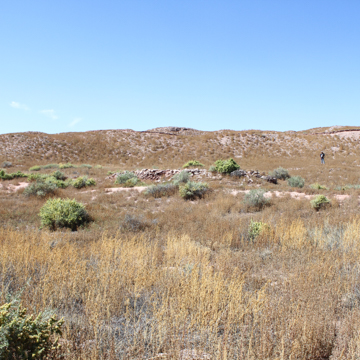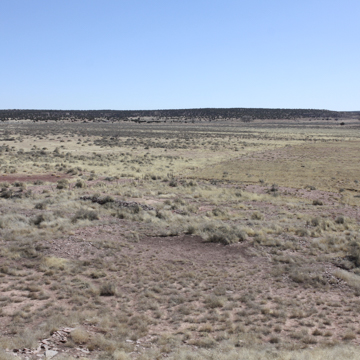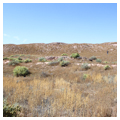You are here
Hawikku Pueblo
The ancestral Zuni pueblo of Hawikku was an important site of first encounters between Spanish and Pueblo cultures in the American Southwest. Today, crumbling mounds of rock along a low promontory are all that attest to what was once a thriving town of 600 to 1,000 people, where the coercive pressures of Spanish colonization often resulted in violence and ultimately led to the town’s depopulation during the 1680 Pueblo Revolt.
The date of its founding is unknown, but Hawikku was one of several pueblos along the Zuni River in the 1400s, and was still occupied when the Spanish arrived in 1539. An enslaved North African named Estevan, scouting for the Franciscan friar Marcos de Niza, alarmed the Zunis who imprisoned and eventually executed him. In Mexico, De Niza’s accounts fueled the ambitions of Francisco Vázquez de Coronado, who attacked and captured the Pueblo in 1540, remaining there with his soldiers for four months.
Excavations of the site, carried out by Frederick Webb Hodge in 1917–1923, revealed houses in seven distinct housing blocks around an irregular hilltop plaza. Rooms were rectilinear and constructed organically over time, resulting in additive or aggregated structures. The northern and western blocks show more intentional plans, with households occupying single files of rooms built out from common back walls, and no openings through their shared party walls. Sandstone laid in rough ashlar courses with adobe mortar was finished with mud plaster. The lower levels held storage rooms while working and living quarters were on the upper floors in rooms with small rectangular hearths set in packed earth floors. Log roof beams spanned the rooms, covered with saplings supporting grass or brush matting, and a layer of tamped earth. Ring-shaped sandstone hatchways provided ventilation and entry via ladders.
Hodge’s Hawikku excavations also uncovered two types of ceremonial chambers or kivas. A pair of well-built circular rooms, located within a walled precinct southwest of the pueblo belongs to the first type; ceramic evidence suggests a date before 1350. A later rectangular kiva in the main plaza belongs to the second type. Measuring roughly 21 by 14 feet, this kiva had low-quality, dry-stacked stone walls finished with red adobe plaster over vegetal furring and large timber beams supporting a flat earthen ceiling and central hatchway. The floor had a slab pavement and such features as a fireplace, ventilator shaft, and holes for loom anchors. Tree ring samples dated this kiva between 1381 and 1480, although reanalysis could not confirm these dates.
After Coronado, Spanish contact remained sporadic until the establishment of a mission in 1629. The first Hawikku mission was an existing pueblo house that Fray Roque de Figueredo adapted as an interim chapel and friary ( convento). It was short lived, for in 1632 the Hawikku community revolted against Spanish demands that they abandon their religious practices and attend Christian mass. Zunis killed two friars and burned the provisional structure.
A more substantial, single-nave adobe church and attached convento was complete by 1661. Similar in design to the Halona (Zuni Pueblo) mission, the Purísima Concepción church was 112 feet long and 36 feet wide, with its polygonal apse to the southwest. Two towers flanked the main portal and wooden balcony of its facade, while a choir loft stood inside the entryway. Carved wooden beams supported a flat, packed earth roof, and murals imitating ceramic tiles ornamented the church and sacristy walls. The convento adjoined the southeast side of the church, with a square plan and open patio at center, like a medieval cloister. Apaches burned the mission and killed its friar in 1672, and only a stone retaining wall now marks its location.
The Hawikku site was never reoccupied after its residents relocated to the mesa atop Dowa Yalanne during the 1680 Pueblo Revolt. The site belongs to Zuni Pueblo, which recently added a walking trail to facilitate interpretive visits. Tours may be arranged through the Zuni Pueblo Department of Tourism.
References
Bloom, Lansing B., trans. “Fray Estevan de Perea’s Relacion.” New Mexico Historical Review 8, no. 3 (July 1933): 211-235.
Damp, Jonathan E. The Battle of Hawikku: Archaeological Investigations of the Zuni-Coronado Encounter at Hawikku, The Ensuing Battle, and the Aftermath during the Summer of 1540. ZCRE Report No. 884. Zuni, NM: Zuni Cultural Resource Enterprise, 2005.
Hodge, Frederick Webb. Circular Kivas near Hawikuh, New Mexico. New York: Museum of the American Indian-Heye Foundation, 1923. Contributions from the Museum of the American Indian-Heye Foundation 8, no. 1, Hendricks-Hodge Expedition.
Hodge, Frederick Webb. History of Hawikuh, New Mexico, One of the So-Called Cities of Cíbola. Los Angeles: Southwest Museum, 1937.
Hodge, Frederick Webb. “A Square Kiva at Hawikuh, New Mexico.” In So Live the Works of Men, edited by Donald D. Brand and Fred E. Harvey, 195-214. Albuquerque: University of New Mexico Press, 1939.
Kennedy, Tom R., and Dan Simplicio. “First Contact at Hawikku (Zuni): The Day the World Stopped.” Telling New Mexico: A New History, edited by Marta Wiegle with Frances Levine and Louise Stiver, 63-71. Santa Fe: Museum of New Mexico Press, 2009.
Kintigh, Keith W. Settlement, Subsistence, and Society in Late Zuni Prehistory. Tucson: University of Arizona Press, 1985.
Smith, Watson, Richard B. Woodbury, and Nathalie F.S. Woodbury. The Excavation of Hawikuh by Frederick Webb Hodge: Report of the Hendricks-Hodge Expedition, 1917-1923. New York: Museum of the American Indian Heye Foundation, 1966.
Writing Credits
If SAH Archipedia has been useful to you, please consider supporting it.
SAH Archipedia tells the story of the United States through its buildings, landscapes, and cities. This freely available resource empowers the public with authoritative knowledge that deepens their understanding and appreciation of the built environment. But the Society of Architectural Historians, which created SAH Archipedia with University of Virginia Press, needs your support to maintain the high-caliber research, writing, photography, cartography, editing, design, and programming that make SAH Archipedia a trusted online resource available to all who value the history of place, heritage tourism, and learning.




















